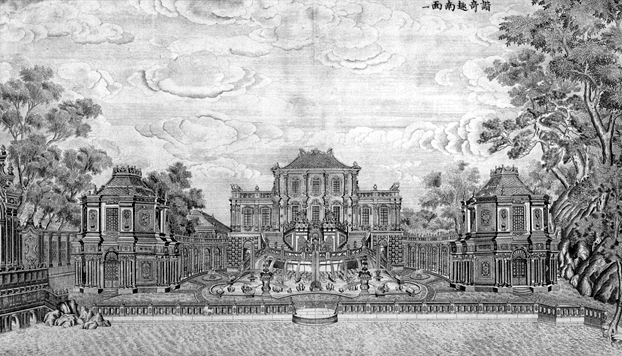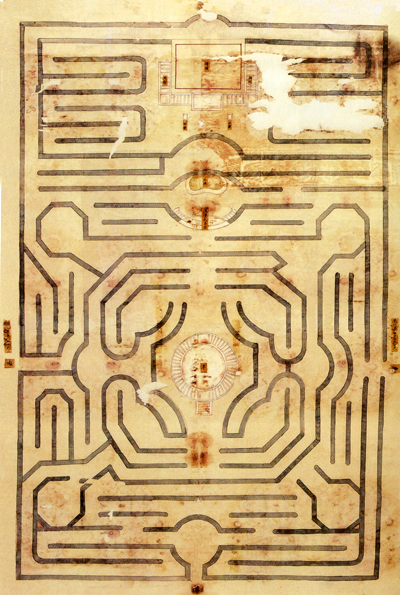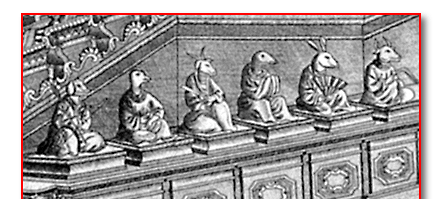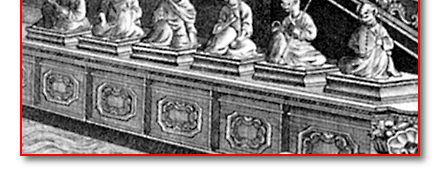| |
THE EUROPEAN PALACES
In 1783 the Qianlong emperor commissioned a set of 20 copperplate engravings of the European pavilions by Chinese Imperial Academy painter Yi Lantai. Like the design of the complex itself, these works are a product of aesthetic hybridity. Produced by the Manchu court artist Yi Lantai, who probably studied under Castiglione, the scenes utilize both Western and Chinese modes of artistic depiction. 1 There were copies kept in the palaces themselves, and 200 sets were given to imperial relatives, high officials, and other guests. 2 They form the main documentation of the European-style buildings as they were meant to be. The complete set of engravings is reproduced here and in the Visual Narratives.
| |
20 Views of the European Palaces
Xiyanglou 西洋樓

1. Pavilion Harmonizing Surprise and Delight
Xieqiqu 諧奇趣, south façade
|
|
|
|
 |
| |
[ymy2001]
| |
The imposing and magnificent Pavilion Harmonizing Surprise and Delight (Xieqiqu) was the first structure to be built. The south view showed an imposing façade and grand circular stairway. On each side were two-storied gazebos connected by walkways to the central building, flanking the pool and fountains in the center. From them the emperor enjoyed viewing the fountain displays and musical accompaniments. In the foreground was a lake with a balustrade. |
|
| |
2. Pavilion Harmonizing Surprise and Delight
Xieqiqu 諧奇趣, north façade
|
|
|
|
| |
[ymy2002]
| |
The north façade was almost as ornate, with its own outdoor staircases, courtyard fountains, and formal garden. What the emperor most enjoyed was viewing this and later buildings from the outside, admiring their symmetry and ornamentation. The palaces in the 20 Views seem two-dimensional because they were meant to emphasize the view or vista, just as the emperor most appreciated it. |
|
 |
| |
3. Reservoir
Xushuilou 蓄水樓, east façade
|
|
|
|
| |
[ymy2003]
The third view shows the east façade of the Reservoir, a building on the western edge of the compound, just north of the Xieqiqu. |
|
| |
 |
| |
4. Gate to the Garden
Huayuanmen 花園門, north façade
|
|
|
|
| |
[ymy2004]
This was the northern façade of the gate to the Maze, viewed from within the Garden. On the other side of the wall, the Reservoir can be seen. |
|
| |
 |
| |
5. Garden
Huayuan 花園, front view
Also known as the Maze (Migong 迷宮)
|
|
|
|
| |
[ymy2005]
By the
17th century, mazes were common in European gardens; Hampton Court had a large maze constructed in 1690. The Yuanmingyuan maze had an octagonal
gazebo at the center, from which the emperor enjoyed watching Autumn Moon festivities. Court maids in rows displayed 10,000 lanterns in formation, and afterwards imperial consorts and guests ran through the maze toward the emperor, who rewarded them with candies and fruit when they reached him.
3
|
|
 |
  A diagram of
A diagram of
the Maze
Reproduced from Qianlong yupin Yuanmingyuan 乾隆御品圓明園 (Qianlong’s Imperial Treasure Yuanmingyuan), Guo Daiheng 郭黛姮, ed. (Hangzhou: Zhejiang guji chubanshe, 2007). Original held at Qinghua University School of Architecture.
[ymy4018] |
| |
 |
| |
6. Aviary
Yangquelong 養雀籠, west fašade
|
|
|
|
| |
[ymy2006]
Peacocks and other birds were kept at the Aviary. The walls of one cage were decorated with paintings of boats and pheasants. The west façade faced toward the courtyard behind the Xieqiqu. Through this gate a path led to the next section of buildings to the east (Fangwaiguan and surroundings). 4 |
|
| |
| |
7. Aviary
Yangquelong 養雀籠, east fašade
|
|
|
|
| |
[ymy2007]
The other side of this aviary gate was decorated with carved white marble fountains. |
|
| |
 |
| |
8. Observatory of Lands Beyond
Fangwaiguan 方外觀, front view
|
|
|
|
| |
[ymy2008]
Built in 1759, the Observatory of Lands Beyond (Fangwaiguan) was in the second section to be developed. It featured squared columns and a bronze stairway to the second floor. Inside were two large stone tablets with Arabic inscriptions.
Legend has it that General Zhaohui, returning from a successful expedition to Turkestan in 1760, brought back a beautiful princess, who became the emperor’s favorite. She was called the Fragrant Concubine (Xiangfei) for the natural fragrance of her body. She is said to have resided in the Observatory of Lands Beyond, renaming it the Muslim Mosque (Qingzhen Si), but it is unlikely that she or anyone else actually resided in the European pavilions. 5
Westerners who toured and photographed the ruins of the European Palaces after 1860 referred to this building as the Belvedere. In today’s Yuanmingyuan Park, its ruins can be quickly identified by its distinctive square, segmented columns. |
|
| |
 |
| |
9. Bamboo Pavilion
Zhuting 竹亭, north façade
|
|
|
|
| |
[ymy2009]
Directly in front of the Fangwaiguan (view 8) there was a bridge with a marble balustrade leading across a moat to a garden called the Bamboo Pavilion (Zhuting). Five gazebos were connected by walkways. |
|
| |
 |
| |
10. Hall of Calm Seas
Haiyantang 海宴堂, west façade
|
|
|
|
| |
[ymy2010]
The Hall of Calm Seas (Haiyantang) was the most elaborate of the palaces. There is a copperplate engraving for each of its four facades. The main façade—most frequently pictured—was on the west side. The balustrades of the elaborate staircases on the right and left of the building were carved marble, from which sprang 50 little fountains. The water from the fountains cascaded from one level of the balustrade to the next until it landed in three stone basins at the bottom.
|
|
 |
  detail: zodiac animals (left)
detail: zodiac animals (left) |
  detail: zodiac animals (right)
detail: zodiac animals (right) |
 |
| |
At the center was a large basin flanked by 12 bronze zodiac animals, six on either side—rat, ox, tiger, hare, dragon, snake, horse, goat, monkey, rooster, dog, and boar—each of which spouted water for two hours of the day. At noon, all 12 animal mouths spouted. In View 10, the horse indicates the time from 11 am to 1 p.m. After the Jesuit who installed the mechanism died, no one knew how to repair it, and water had to be raised in buckets. 6
After the 1860 destruction of the Yuanmingyuan, the ruins of the west side of the Haiyantang were among the most memorable—easily recognized by the large clam-shaped shell that formed the basin of the fountain. |
|
| |
 |
| |
11. Hall of Calm Seas
Haiyantang 海宴堂, north façade
|
|
|
|
| |
[ymy2011]
A large reservoir designed to provide water to the fountains was situated between hydraulic machines whose height is indicated by the peaks in the building roof. 7 |
|
| |
| |
12. Hall of Calm Seas
Haiyantang 海宴堂, east façade
|
|
|
|
| |
[ymy2012]
These elaborate zig-zag stairs apparently led up to the reservoir. 8 |
|
| |
| |
13. Hall of Calm Seas
Haiyantang 海宴堂, south façade
|
|
|
|
| |
[ymy2013]
The decoration, including windows, on the north and south façades were trompe l’oeil. |
|
| |
 |
| |
14. Observatory of Distant Oceans
Yuanyingguan 遠瀛觀, front view
|
|
|
|
| |
[ymy2014]
In the central section of the European Park was the Yuanyingguan (Observatory of Distant Oceans). As Malone tells us:
This large gray brick building was lavishly decorated with carved white marble around the doors and windows and with two elaborately and intricately carved marble pillars before the main door. It stood on a terrace which projected beyond the main line of the north wall of the park at this point, and faced upon the Great Fountains, for which it formed a rich background, as viewed from the throne shown in Engraving Number Sixteen. 9
Qianlong sometimes used this building as a resting place. It originally housed six Beauvais tapestries given to the emperor by Louis XV in 1767. 10 The ornate carved marble pillars of the Yuanyingguan are among the easily identified remains that visitors to the Yuanmingyuan Park can see today. |
|
| |
 |
| |
15. Great Fountain
Dashuifa 大水法, front view
|
|
|
|
| |
[ymy2015]
The Great Fountain was the most elaborate of the fountains and stood alone without being part of a major building. To its right and left were two large fountains shaped as pagodas or pyramids. In the main pool there was another fountain in the shape of 11 animal figures: one deer and 10 hounds. When the fountains were activated, it reportedly appeared as if the hounds were chasing the deer. 11 |
|
| |
| |
16. Throne for Observing the Great Fountain
Guanshuifa 觀水法, front view
|
|
|
|
| |
[ymy2016]
Facing the Great Fountain was a throne where the emperor sat to watch the fountain in action. The Yuanyingguan, which was elevated, was visible behind the Great Fountain, although this is not apparent in View 15. As usual, the fountains and buildings formed an elaborate vista for the pleasure and entertainment of the emperor. |
|
| |
 |
| |
17. Gate to Perspective Hill
Xianfashanmen 線法山門, front view
|
|
|
|
| |
[ymy2017]
The last four engravings depict views near Perspective Hill (Xianfashan), at the eastern end of the complex. Malone describes this structure as “a triple gateway, resembling a European triumphal arch.” 12 |
|
| |
| |
18. Perspective Hill
Xianfashan 線法山, front view
|
|
|
|
| |
[ymy2018]
This artificial hill was approached by circular paths that led to a gazebo at the top. From this high point the emperor could view the surrounding landscape and other structures. The trees in this engraving are covered with light snow.
|
|
| |
| |
19. Perspective Hill
Xianfashan dongmen 線法山 東門, east gate
|
|
|
|
| |
[ymy2019]
Descending from the other side of Perspective Hill, the emperor could proceed through the elaborately decorated East Gate to an artificial lake.
|
|
| |
| |
20. Perspective paintings east of the lake
Hudong xianfahua 湖東線法畫
|
|
|
|
| |
[ymy2020]
This last engraving depicts a view of a European town seen across a lake. Here, Malone tells us:
To produce an illusion of distance…houses were partly modeled and partly painted on walls, five on each side, set like the wings of a stage, those farther back being nearer together. 13
Like everything else in the European section, the view from the lake was an illusion.
|
|
|







